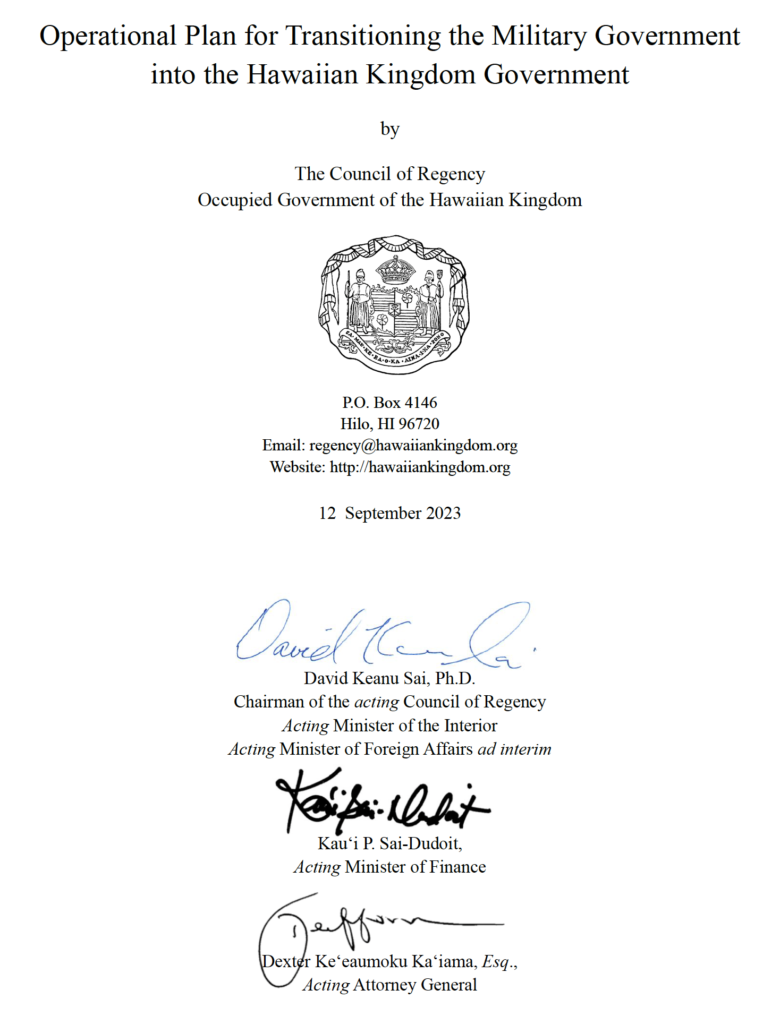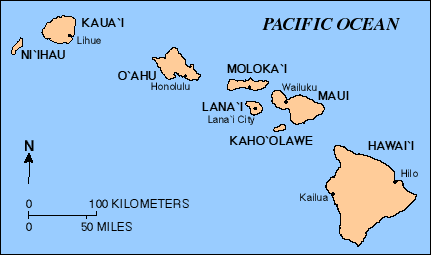Operational Plan for Transitioning the Military Government into the Hawaiian Kingdom Government
ASIA--PACIFIC, 18 Sep 2023
Hawaiian Kingdom Blog – TRANSCEND Media Service
Bringing the U.S. Occupation to an End
On 12 Sep 2023, the Council of Regency approved its Operational Plan for Transitioning the Military Government into the Hawaiian Kingdom Government. The Council of Regency has drafted a proposed Treaty of Peace, and sees that the occupation can come to an end in 3 years. This operational plan assumes that the military government has been established in accordance with its August 14, 2023, Operational Plan for Transitioning the State of Hawai‘i into a Military Government and moves it to the next phase where the occupation will come to an end. These operational plans are comprehensive and incorporates Hawaiian Kingdom laws and the law of occupation.
The mandate of the Council of Regency is through all legal means, compel the United States and the State of Hawai‘i to begin to comply with international humanitarian law and the law of occupation in order to bring the prolonged occupation to an end. It has been 23 years since the Council of Regency returned from oral hearings held at the Permanent Court of Arbitration, in Larsen v. Hawaiian Kingdom arbitration proceedings in December of 2000.
As part of phase II of its strategic plan—exposure of the Hawaiian Kingdom as a State under international law, the Council of Regency focused on academic research to not only draw attention to the fact that the Hawaiian Kingdom continues to exist, but how international humanitarian law and the law of occupation provides the process for the occupation to eventually come to an end. At first glance, for the State of Hawai‘i to transform itself into a military government would appear counter intuitive to a problem that came about by the U.S. military itself when they invaded the Hawaiian Kingdom on January 16, 1893.
The U.S. military is the most regulated organization in the United States. It operates like it is its own government with the exception of a legislative body. It has a general that oversees all branches of the military, a chain of command with superiors at every level to the lowest ranking soldier, and a judicial system to hold to account soldiers who violate regulations called the Uniform Code of Military Justice.
What the U.S. military did when they invaded Hawaiian territory and caused the overthrow of the Hawaiian Kingdom government was unlawful, and admitted being so by President Grover Cleveland, but that didn’t mean it ended then and there. When a government of another country is militarily overthrown by an “act of war,” it triggers duties and obligations upon the invader that are not just military regulations, but also international law called international humanitarian law and the law of occupation.
The law of occupation in 1893 obligated the United States military to establish a military government to administer the laws of the occupied State until a treaty of peace has been negotiated and agreed upon that will either bring the occupation to an end or the occupied country could cede itself to the former occupying State. To not administer the laws of the occupied State by a military government is a war crime by omission, and the imposition of American laws over Hawaiian territory is the war crime of usurpation of sovereignty during military occupation. There are no statutes of limitations for war crimes.
Until there is a treaty of peace, the occupation continues and war crimes continue to be committed with impunity. There is no treaty of peace whereby the Hawaiian Kingdom ceded itself to the United States. The Hawaiian Kingdom continues to exist because of the international principle of inalienable sovereignty, and the Permanent Court of Arbitration acknowledged this in Larsen v. Hawaiian Kingdom in 1999.
A military government is also a misnomer. It is not a government comprised of the military, but rather the civilian government of the occupied State where only the head is replaced by a military governor, which is the highest-ranking Army officer that is in effective control of the territory of an occupied State. That officer is the State of Hawai‘i Adjutant General, Major General Ken Hara. According to Army regulations, the 322nd Civil Affairs Brigade at Fort Shafter, Island of O‘ahu, advises military governors on the function of transitioning governance—military government. U.S. Army Field Manual 3-57 is the manual for Civil Affairs units.
____________________________________
Hawaiian Kingdom Blog – Weblog of the acting government of the Hawaiian Kingdom presently operating within the occupied State of the Hawaiian Islands by the USA.
Go to Original – hawaiiankingdom.org
Tags: Anglo America, Asia and the Pacific, Coup, Hawaii, Hawaiian Culture, Hawaiian Sovereignty, Invasion, Occupation, Pacific Islands, Polynesian Culture, USA
DISCLAIMER: The statements, views and opinions expressed in pieces republished here are solely those of the authors and do not necessarily represent those of TMS. In accordance with title 17 U.S.C. section 107, this material is distributed without profit to those who have expressed a prior interest in receiving the included information for research and educational purposes. TMS has no affiliation whatsoever with the originator of this article nor is TMS endorsed or sponsored by the originator. “GO TO ORIGINAL” links are provided as a convenience to our readers and allow for verification of authenticity. However, as originating pages are often updated by their originating host sites, the versions posted may not match the versions our readers view when clicking the “GO TO ORIGINAL” links. This site contains copyrighted material the use of which has not always been specifically authorized by the copyright owner. We are making such material available in our efforts to advance understanding of environmental, political, human rights, economic, democracy, scientific, and social justice issues, etc. We believe this constitutes a ‘fair use’ of any such copyrighted material as provided for in section 107 of the US Copyright Law. In accordance with Title 17 U.S.C. Section 107, the material on this site is distributed without profit to those who have expressed a prior interest in receiving the included information for research and educational purposes. For more information go to: http://www.law.cornell.edu/uscode/17/107.shtml. If you wish to use copyrighted material from this site for purposes of your own that go beyond ‘fair use’, you must obtain permission from the copyright owner.

